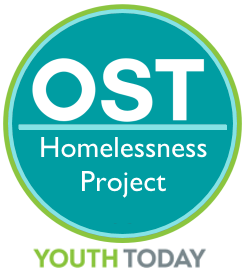VIDEOGRAPHER: KELLEY BOSTIAN
(EDITOR’S NOTE: This is the sixth of six articles in an occasional series about the intersection of OST and students experiencing homelessness.)
As the pandemic continues, the number of people experiencing homelessness could rise — especially if eviction moratoriums are lifted. More children in summer and after-school programs could be impacted.
 How can after-school providers respond?
How can after-school providers respond?
One thing people in the field can do is to learn more about homelessness among children and youth and how to address it — then use and build on the relationships they have with kids and families.
Training about homelessness is important, said Daniel Zavala, director of policy and strategic communications at Building Changes, a nonprofit that pulls together government, philanthropy and other nonprofits to work on homelessness in Washington state.
“We are likely to see a mass influx of people experiencing a housing crisis,” he said. While after-school providers might not have the resources available to train their staff, they could ask state agencies or associations to provide it, he said.
After-school providers need to check in with students
After-school programs can help fill the gap created when schools closed. Schools had provided stability as well as meals and other resources for kids experiencing homelessness, Zavala said.
“Many students have actually dropped out of [school] rosters and contact has been severed,” he said.
Bellwether Education Partners estimates 3 million students across the country are no longer on the school rolls. In Miami-Dade County public schools, for example, 16,000 fewer students are enrolled.
Outreach and identification look different with school being closed, Zavala said.
“One of the things we’ve been learning is the importance of relationships,” he said.
“It will be on [after-school] providers to understand, to have those relationships, to know the language to build that trust, so that identification can happen properly.
“Be intentional about check-ins,” he urged.
About three-fourths of children and youth identified as homeless are living “doubled up” in another household, according to the National Center for Homeless Education. About 15% are in shelters, more than 6% are temporarily in motels and 4% are living unsheltered. Families may be living at campgrounds or in cars.
District liaison can help providers
If youth workers and community members suspect a child is homeless, they should look more closely, learn more and then act, according to Schoolhouse Connection. The organization suggests ways to talk to children and parents with sensitivity and respect.
After-school providers also need to know that federal law gives homeless students certain rights, and it mandates the responsibilities that schools have to them.
VIDEOGRAPHER: KELLEY BOSTIAN
Under the McKinney-Vento Education for Homeless Children and Youth Act, each school district is required to have an employee, a McKinney-Vento liaison, who ensures that kids get services required under the law.
After-school providers can contact this district liaison.
Students have the right to stay in the same school even if they move, and they have the right to get transportation to that school as long as it is in the child’s best interest.
They can enroll in school without the documents schools usually require. They get free school meals and help with supplies and other needs. Youth on their own can get extra support, and young children can get connected to early childhood services.
States and localities may also require that certain services be provided, Zavala said. Each state has a McKinney-Vento statewide coordinator who should be able to provide information about such programs, he said.
After-school programs are an important component in addressing the needs of kids who are housing-insecure. For example, a recent report from Building Changes noted that school districts that show better outcomes for students experiencing homelessness had a variety of after-school opportunities for students.
Within those programs, flexible transportation and the provision of meals were important, the report said.
An effort to monitor and address the opportunity gap was also a characteristic of districts that showed better outcomes for kids experiencing homelessness, as were specific efforts at relationship-building and structured social-emotional programs, it said.
Homelessness disproportionately affects young people of color, and programs addressing those groups were important, the report said.






























